“History Repeating” by Quinn Papazian
January 11, 2017
Artists are always seeking new inspiration—from natural forms to urban cities, historical objects to contemporary design—and when you find something that truly resonates with you, it sticks for a long time. Quinn Papazian is the Design Studio Manager at the Museum of Fine Arts in Boston and has been cataloging patterns she finds via Instagram. Here she shares her experiences of being exposed to so many historical objects in hopes to inspire SDA members with their beauty.
As a pattern lover, I am fortunate to have close-up access to incredible works from one of the most comprehensive art collections in the world. My position as the Design Studio Manager at the Museum of Fine Arts in Boston (the MFA), allows me to roam every day through empty galleries before they open and see masterpieces before they are displayed under glass. I hope sharing my discoveries will inspire new projects and enrich your design process.
A few years ago I started graphic design school at night and the museum was my classroom while I worked during the day. What began as a desire to document the colors and patterns around me evolved into a bigger project of sharing my art inspiration with others.
@museummosaics on Instagram is now the home for historical pattern photos I discover during my work and travels. Instagram is a wonderful platform for designers—I have so much fun curating my posts and connecting with other creatives. On a personal level, the project reminds me not to be complacent after nine years at the MFA; I must get away from my desk to see the artwork. It also deepens my knowledge of art techniques, mediums, and history, which have enriched my designs.
As I collect more photos to form a library of patterns, I am struck by the universal nature of pattern types. Connections between particular color schemes and motifs span centuries and continents. Is there anything more timeless than zig zags?
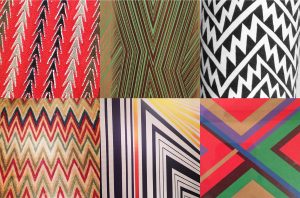
Clockwise from top left: Native American finger-woven sash, possibly Huron. Eastern Great Lakes region, early 19th century. Diagonally plaited wool with beads. // Jason Middlebrook Vertical Landscape Painting 2011, acrylic on black walnut plank. // Carmel Lewis Earthenware Jar (Acoma Pueblo) 2000-2002. // Indian manuscript cover (detail) 16th or 17th century, silk embroidery on cotton. // Jason Middlebrook Tread Lightly 2014, mural in contemporary art wing at the MFA. // Eduardo Paolozzi Moonstrips Empire News 1967, screenprint.
The patterns in my first Mini Mosaic Movie all share a central medallion pattern, yet they range from the 800s to 2012, from Iraq to Nova Scotia, and from weaving to furniture making.
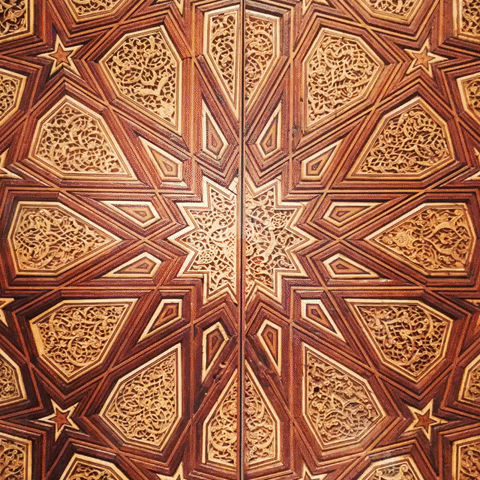
Images: Islamic carved wooden panel, early 9th century. // Chair with porcupine quillwork panels, Nova Scotia, Mi’kmaq, mid-19th century. // Daniel Pabst Cabinet circa 1875, carved Renaissance revival style. // Christy Oates Kaleidoscope Algorithm 2012, fifteen segments of various woods. // Carved wooden panel from Iraq, Abbasid period, early 9th century.
In the same way that many surface designers build digital patterns starting with a single square, I use Instagram’s default crop of a square to frame the most interesting compositions.
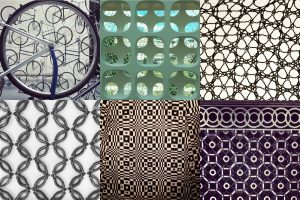
Clockwise from top left: Ai Wei Wei Forever 2003, 64 stacked bicycles. Part of the ‘Megacities Asia’ exhibition at Museum of Fine Arts, Boston. // Erwin Hauer’s sculptural screen covering a shattered window pane waiting for repair at the MFA. // Pierre Fouché The Judgment of Paris (detail) 2013. // Samuel Yellin’s iron radiator grill pattern 1915. // Scott Paper Co. American paper dress pattern 1966, at the Victoria and Albert Museum, London. // Iron grate flooring at the National Gallery of Art, London.
The square crop is also useful for capturing a swatch of a large repeating pattern so I can deconstruct how the pattern was designed. Squares are the building blocks of most repeating patterns.
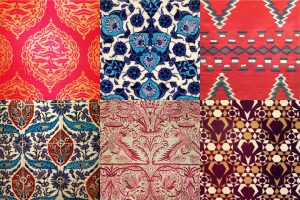
Clockwise from top left: Silk fragment from Turkey, about 1550. Victoria and Albert Museum. // Pattern from a Turkish tile, Ottoman Empire, 1520. Harvard Art Museums. // Navajo serape from Arizona or New Mexico, 1890-1900. // Turkish tiles from 1580 at the Victoria and Albert Museum. // Embroidery to celebrate the arrival of Peru’s new viceroy, Diego de Benavides, in 1661. It’s a cross-cultural mixture of influences that includes Chinese figures, European personifications of seasons and virtues, and Andean rodents. // Koloman Moser Starflower 1902, endpaper. Harvard Art Museums.
Sprawling floral patterns are so much fun to photograph, and they might be the most universally adored motif that I find. Whimsical flowers and vines appear in almost every period and culture of art history.
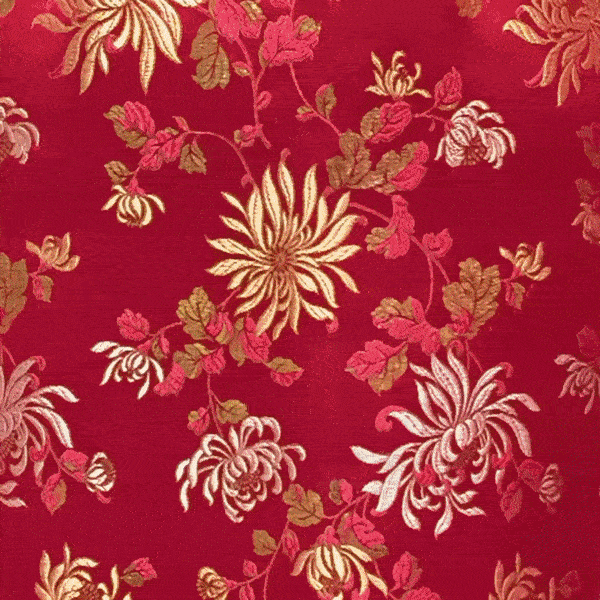
Images: Frankie Welch Dress designed for First Lady Betty Ford 1974. Peabody Essex Museum. // John La Farge The Fish about 1890, stained glass. // Upholstery from a French armchair, 1715-1725. // Vincent van Gogh La Berceuse (detail) 1889. // Embroidery by Ursuline nuns in Quebec City around 1700. Indigenous imagery with Chinese motifs—a blending of cultures in New France. // Kehinde Wiley John, 1st Baron Byron (detail) 2013. // Embroidered bed cover from the Victoria and Albert Museum, designed in India for western export, about 1725-50.
These images are meant to be enjoyed as pops of color and works of art, but I also hope that surface pattern designers dig deeper. Identifying trends among centuries of pattern design can provide inspiration and insight into our work, enrich our process, and help us connect to the long line of designers before us.
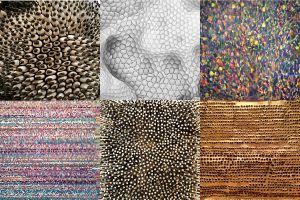
Clockwise from top left: Iris van Herpen and Neri Oxman Anthazoa 2013, 3-D printed cape and skirt by from the Voltage Collection. From the MFA’s exhibition ‘#techstyle.’ // Tara Donovan Untitled 2003, styrofoam cups, hot glue. // Gustav Klimt Pear Tree in Full Bloom 1903. Harvard Art Museums. // Fukumoto Shigeki Sun Beam 2001, small pieces of dyed cloth, Japanese washi tape, woven. // Günter Uecker Feld (Field) 2008, nails, acrylic on canvas, mounted to board. // Mathias Goeritz Message: Wall Decoration 1960, gold paint, stainless steel, mounted on wood.
I’d love to hear from you—please find me on Instagram and share your thoughts!
Quinn Papazian is a freelance graphic designer and Design Studio Manager at the Museum of Fine Arts, Boston. She studied anthropology at Tufts University and graphic design at Massachusetts College of Art and Design. Quinn posts photographs of art museum patterns on Instagram. Her website and blog can be found on http://quinnpapazian.com/.
*All photos by Quinn Papazian. Photos were taken at the Museum of Fine Arts, Boston unless noted otherwise. Artwork rights belong to credited artists. Please do not reproduce without permission.


1 Comment
Sherry Leary says
January 12, 2017 at 9:16 pm
Thank-you for the reminder that inspiration is everywhere! sml
Related Blog Articles
Creative Process
“Fringe: On the Edge of Fiber” — Out Now!
Creative Process
Friday Fibers Roundup: Craft & Color
Creative Process
“Standing Tall: A Heart-FELT Reflection” by Martien van Zuilen